Intel announces Tunnel Creek - Atom E600 System on Chip
by Brian Klug on September 14, 2010 2:53 PM EST- Posted in
- CPUs
- Intel
- Atom
- Moorestown
- E600
At the end of this morning's keynote at IDF 2010, Intel announced the Atom Processor E600 series. It's a Moorestown-like SoC designed for embedded applications.
Intel is really targeting this SoC at the consumer electronics industry and a variety of applications that could benefit from both better integration. Demonstrations included an E600 SoC powering a car navigation system and a variety of dynamic 3D content or video on a separate passenger entertainment display. You can see it running a PowerVR graphics demo if you look closely in the photo below.
E600 brings everything onboard for the platform, including PCI-E for using the E600 in a multitude of different capacities. Either bring your own PCH or build one yourself - Intel already showed examples of Realtek, OKI, and ST Microelectronics on stage. If you're just building a desktop, Intel has a fairly standard platform controller hub called the EG20T for control like ethernet, SATA and USB. Intel really hopes that their embedded Atom platform will bring cost of system integration way down.
The E-series is a 45 nm part, 32nm and 22nm Atom series parts will follow.


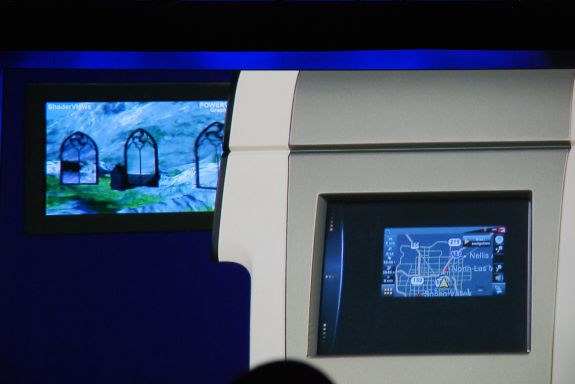
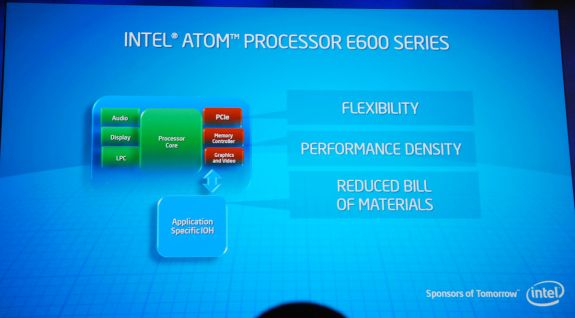
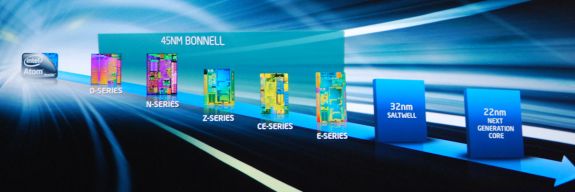
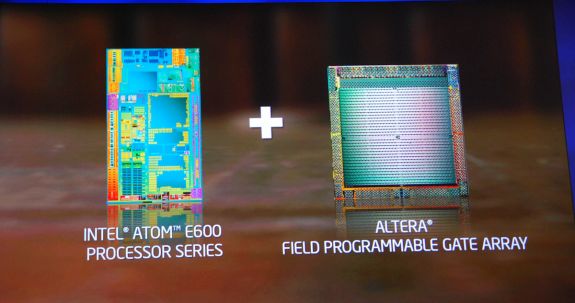
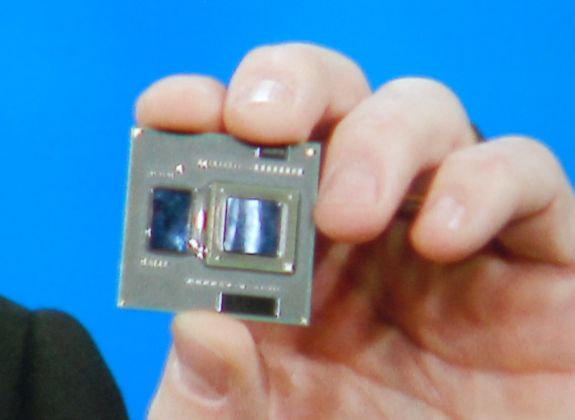
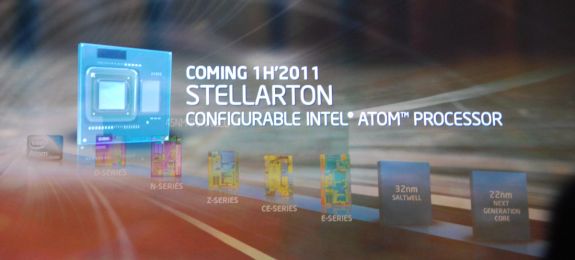








26 Comments
View All Comments
2uantuM - Thursday, September 16, 2010 - link
A 100MHz DSP on an FPGA would CRUSH the best CPU money can buy in terms of processing power. CPUscores are not parallelized, so they can only do 1 operation per clock cycle. The amount of work an FPGA does in a single clock cycle is limited by only the size of the FPGA.It's not comparing apples and oranges at all.
2uantuM - Thursday, September 16, 2010 - link
It's like comparing apples and oranges*Zoomer - Wednesday, September 22, 2010 - link
It all depends on the workload. There are many papers out that that tries to compare them. Try Chimera, Piperench etc.Problem with this: If you think multicore programming was hard, this is a whole new ballgame.
For example, is:
if (a and b)
equal to
if (a) if (b)
(No, it may not)
vol7ron - Tuesday, September 14, 2010 - link
My guess is that there's a little latency hit too, in addition to the power woes.I'm curious how someone might take advantage of something like this in a Virtualization environment eg mutli-core servers, etc.
yyrkoon - Wednesday, September 15, 2010 - link
Unless Intel puts more useful information out on the subject, and supplies good design software for the FPGA design; I really do not see the appeal for the average Joe tinkerer. But perhaps Intel is targeting established businesses. In which case the average Joe tinkerer is already SoL. Even then, what would a well established company in the embedded market need with a FPGA coupled with an Atom processor ?Also, if Intel were to match the power/performance ratio of say an ARM SoC. Perhaps there would be more appeal. As it stands, being an x86 based SoC with the ability to run windows is not necessarily a plus. Besides the fact that an ARM platform can run on Windows mobile, when/if needed. Which would be more in tune with this hardware.
So yeah, I do not know. It *is* or would be kind of a cool toy if Intel provided the software for programming the FGPA. For free, or at a reasonable price. We'll see how that works out though.
vol7ron - Wednesday, September 15, 2010 - link
My guess is that this isn't for the average-joe.I would suspect that Intel is trying to capture some marketshare from TI. It seems like these processors would be good for any basic level calculating, from internal car systems, to restaurant tracking and deployment systems.
yyrkoon - Wednesday, September 15, 2010 - link
Yeah I know, and it might even be ok with Windows embedded as a Web KIOSK etc.FPGA is a design tool, not an end user solution. That coupled with the fact that most embedded systems businesses are experienced enough to not even have to bother with rabid prototyping through FPGA. They already know what they want/need, and how to implement it. *THAT* was my point.
And how you read it, I pretty much read it too ( Intel playing kids games *again*- that is ). Too bad for Intel though that anyone who is really serious about embedded systems already knows the ARM Architecture. Knows how to setup software around the same, and can very likely do a good portion of it for free. Hell, do not get me wrong, I use Windows on my desktops every day, all day, but in the embedded arena my personal belief is that Microsoft has little, or no place. Not unless they change several things. One of the first, and most important in my own personal book would be support for ARM architecture on more than windows mobile. At the very least, every variant of Windows embedded *should* have support. Last I looked though there was nothing.
Anyways, I am not a MS or Intel hater, But sometimes I think both need to pull their heads out and pay attention to what is going on around them. Intel needs to realize that for Atom to be taken serious in the embedded systems arena, they need to at least offer a variant that can compete with ARM where power efficiency is concerned. I would love to have a tiny, fast enough processor that could run on Windows embedded using the .NET framework. One that used a lot less power than the current Atom CPUs . . .
Or maybe Intel would rather that I used a TI ARM CPU, on Debian, using Mono ? Hey Intel here is a clue. How about stop wasting your time on half assed attempts of wagging your weenie at TI, when you can just put your efforts into something that would actually be a good thing. If TI captures some of "your* netbook, or server market. That would be your own fault for not paying attention to whats going on around you in the world.
Penti - Wednesday, September 15, 2010 - link
Altera supplies the tools as it's their product.Embedded developers would buy a solutions together with software libraries/drivers to use whatever function is implemented in the FPGA for whatever shit you need implemented in hardware. Enthusiasts wouldn't be interested in embedded products any way as they are not the target directly. Just as embedded software developers won't start designing hardware HDL/FPGA designs. Plenty of stuff need FPGAs though, everybody can't make their own ASICs. Intel isn't a FPGA company though. And if you want to use it with something else (not Atom) thats fine, it's not for you. It's not an developer platform for prototyping.
piroroadkill - Wednesday, September 15, 2010 - link
I'm so bored of Atom now.mschira - Wednesday, September 15, 2010 - link
Atom was fun when it was introduced. But it's speed hasn't improved, ever.They were to slow when they came to life, they are way to slow now.
I wonder if that 2Ghz dual A9 ARM can beat an atom?
M.